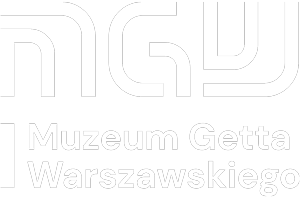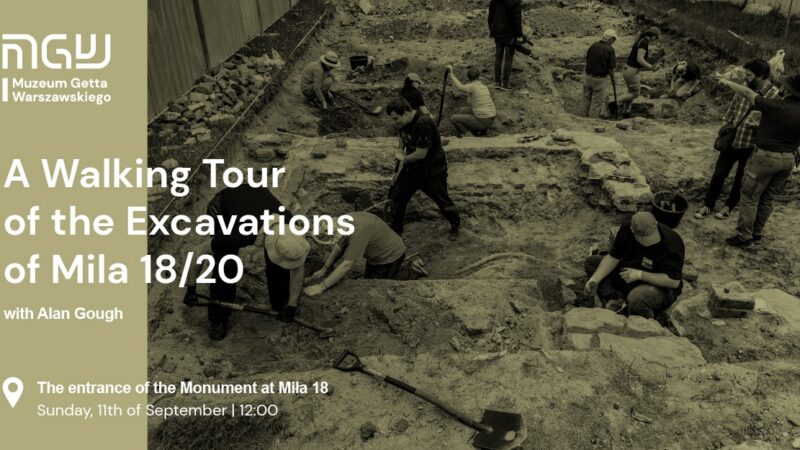Zwiedzanie wykopalisk przy Miłej 18 | A Walking Tour of the Excavations of Mila 18/20
Muzeum Getta Warszawskiego zaprasza na zwiedzanie terenu archeologicznych wykopalisk przy ulicy Miłej 18/20 w Warszawie.
[ENGLISH BELOW]
11 września (niedziela), godz. 12:00, wejście na Kopiec Anielewicza (dawny adres: ul. Miła 18)
- Krótka wycieczka po okolicy wykopu począwszy od ulicy Muranowskiej – ślady przedwojennej Warszawy w teraźniejszości; ulic Niskiej i Stawki – getto warszawskie i mury getta, droga na Umschlagplatz; ulicy Dubois – droga niemiecka i ostateczne zniszczenie getta; Miła 18 – powstanie w getcie warszawskim.
- Co wiemy z zapisu historycznego kamienic na Muranowskiej 37–41 z lat 1869–1943?
- Cechy i znaleziska z piwnic kamienic na Muranowskiej 39 i Muranowskiej 41, w tym: zawalone stropy Muranowskiej 39, biblioteka i artefakty religijne, kuchnie i wejście do bunkra; cechy zespołu bunkrów – wzmocnione ściany Muranowskiej 41, korytarz do Miłej 20, wybrukowany korytarz i znaleziska w piwnicach; cechy zniszczeń i powojennej odbudowy; doświadczenie wykopalisk – uczestnicy i goście z zagranicy i okolicy.
- Spacer w poszukiwaniu nielicznych śladów przeszłości, które jeszcze istnieją. Ta trasa będzie okazją do dyskusji o życiu przedwojennej warszawskiej społeczności żydowskiej, o getcie warszawskim w czasie wojny oraz o okolicy aż po dzień dzisiejszy.
- Wycieczka będzie przebiegać wymienionymi poniżej przedwojennymi drogami: róg Zamenhofa i Miłej i opór styczniowy; starą drogą do Koszar Wołyńskich – miejsca, w którym od sierpnia 1942 r. mieścił się Judenrat; skrzyżowanie Gęsiej i Zamenhofa i iglica kościoła św. Augustyna; wzdłuż Gęsiej do Nalewek – centrum żydowskiej Warszawy.
Przewodnikiem będzie Alan Gough – archeolog, który pracował przy wykopaliskach, prowadzonych przez Muzeum Getta Warszawskiego, a także wieloletni mieszkaniec warszawskiego Muranowa.
Udział w spacerze jest bezpłatny. Język oprowadzania – angielski.
- A short tour of the area around the excavation starting from: Muranowska street – the traces of pre-war Warsaw in the present; Niska and Stawki streets – the Warsaw Ghetto and the ghetto walls, the road to the Umschlagplatz; Dubois Street – The German road and the final destruction of the ghetto; Miła 18 – the Warsaw Ghetto Uprising.
- What we know from the historical record of the houses from Muranowska 37 to 41 from 1869 to 1943?
- Features and finds of the basements of Muranowska 39 and Muranowska 41, including: the collapsed floors of Muranowska 39, the library and the religious artefacts, the kitchens and the entrance to the bunker; features of the bunker complex – the reinforced walls of Muranowska 41, the corridor to Miła 20, the paved corridor and the finds in the basement; features of destruction and post war rebuilding; the experience of excavation – the participants and the visitors from abroad and the local area.
- An extended tour of the wider area with a focus on revealing the few traces of the past which still exist. Along this route there will be an opportunity to discuss aspects of pre-war Warsaw’s Jewish community, the Warsaw Ghetto during the war and the area up to the present day. The tour will follow the pre-war roads listed below: the corner of Zamenhofa and Miła and the January revolt; the old road to the Wołynskie barracks – the place of the Judenrat from August 1942; the crossroads of Gęsia and Zamenhofa and the spire of St. Augustine’s church; along Gęsia to Nalewki – the centre of Jewish Warsaw.
The guide will be Alan Gough – an archaeologist who worked on the excavation at Muranowska 39 and who is also a long term resident of the Muranów area in Warsaw.
Participation is free of charge. The tour will be conducted in English.

